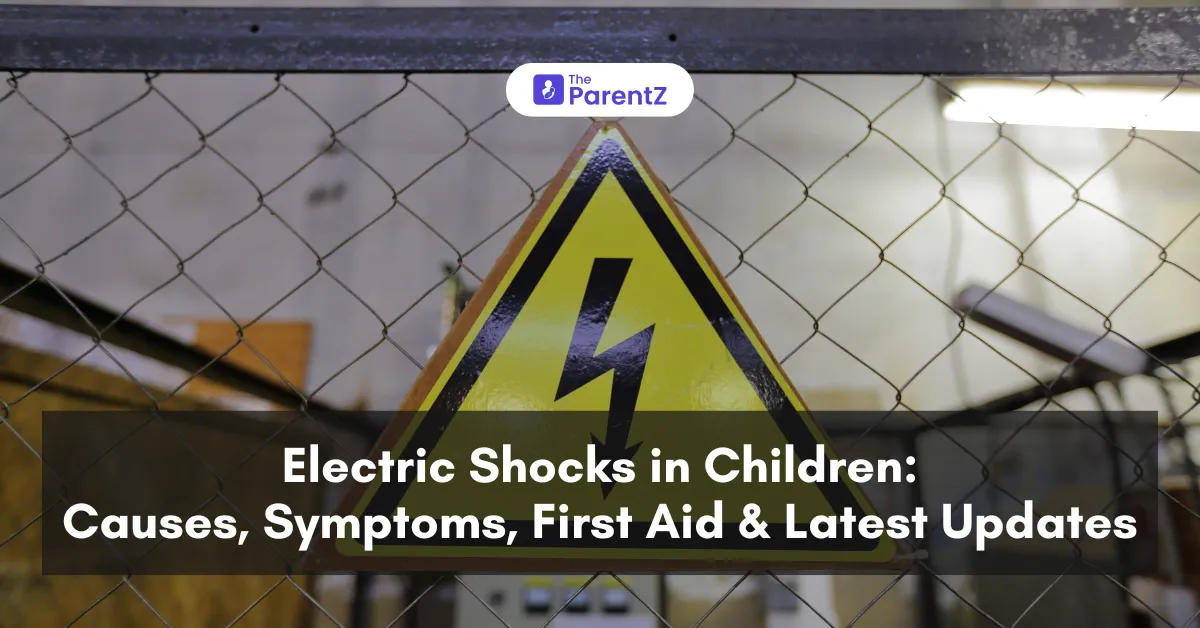Electric shocks in children are a serious yet preventable concern. Young children, especially toddlers, are naturally curious and may unknowingly come into contact with electrical sources, leading to mild to severe injuries. Electrical injuries range from minor burns to life-threatening complications such as cardiac arrest.
Causes of Electric Shocks in Children
Electric shocks occur when the body comes into contact with an electrical source, allowing current to pass through tissues. The severity depends on factors such as voltage, duration of exposure, and the path of the current through the body.
Common Causes:
1. Uncovered Electrical Sockets:
• Children may insert objects or fingers into uncovered outlets, leading to direct exposure.
2. Chewing Electrical Cords:
• Infants and toddlers often put objects in their mouths, including live wires, causing electrical burns.
3. Faulty or Exposed Wiring:
• Damaged wires in appliances, walls, or extension cords increase the risk of electrocution.
4. Contact with Electrical Appliances in Wet Conditions:
• Using electrical devices near water (e.g., hairdryers in bathrooms) raises the risk of shock.
5. Lightning Strikes:
• Although rare, children playing outside during storms may get injured due to direct or indirect lightning strikes.
6. Tampering with Electrical Panels:
• Older children attempting to repair electrical components without proper knowledge may experience high-voltage shocks.
7. Metallic Objects in Power Outlets:
• Inserting metal objects like pins or keys into sockets can cause severe injuries.
8. Electric Toys and Battery Leakages:
• Poorly insulated toys or malfunctioning batteries can lead to minor shocks.
Symptoms of Electric Shock in Children
Symptoms of electrical shock vary based on voltage strength, duration of exposure, and pathway through the body.
Mild Symptoms (Low-Voltage Exposure):
• Tingling or numbness in the affected area
• Minor burns at the point of contact
• Mild muscle contractions
• Temporary confusion or dizziness
Moderate Symptoms (Longer or Higher-Voltage Exposure):
• Pain and muscle spasms
• Visible burns on the skin
• Shortness of breath
• Headache and nausea
Severe Symptoms (High-Voltage or Prolonged Exposure):
• Loss of consciousness
• Severe burns, often deep tissue damage
• Irregular heartbeat (arrhythmia)
• Cardiac arrest
• Seizures
• Respiratory failure
Delayed Symptoms:
Some complications, like nerve damage, memory loss, or cardiac arrhythmias, can appear hours or even days after the incident.
First Aid for Electric Shocks in Children
Immediate Steps to Follow:
1. Do Not Touch the Child Directly
• If the child is still in contact with the electrical source, do not touch them with your bare hands, as you may also get shocked.
2. Turn Off the Power Source
• If safe, unplug the device or switch off the main power supply.
3. Use a Non-Conductive Object to Separate the Child
• If turning off the power isn’t possible, use a dry wooden stick, rubber object, or plastic item to push the child away from the electrical source.
4. Check for Responsiveness and Breathing
• If the child is unresponsive, call emergency services immediately.
• If the child is not breathing, start CPR immediately.
5. Perform CPR if Necessary
• If there’s no pulse or breathing, begin chest compressions and rescue breaths (30:2 ratio) until emergency personnel arrive.
6. Treat Burns and Injuries
• For minor burns: Run cool (not ice-cold) water over the affected area for 10–15 minutes.
• For severe burns: Cover the area with a clean, non-stick cloth and seek medical help.
7. Monitor for Delayed Symptoms
• Even if the child appears fine, they should be evaluated by a healthcare professional, as internal injuries may not be immediately visible.
8. Keep the Child Calm and Comfortable
• Avoid giving food or drink in case of internal injuries.
• Reassure the child and keep them still while awaiting medical attention.
Prevention of Electrical Injuries in Children
1. Childproof Electrical Outlets
• Use safety covers on all unused sockets to prevent accidental insertion of objects.
2. Keep Cords Out of Reach
• Secure electrical cords and avoid placing them where children can chew or pull them.
3. Avoid Water-Electricity Contact
• Never allow children to use electrical devices near bathtubs, pools, or wet surfaces.
4. Regularly Inspect Home Wiring
• Check for exposed, frayed, or damaged wires and replace them immediately.
5. Educate Children on Electrical Safety
• Teach older children about the dangers of electricity and why they should not touch electrical appliances with wet hands.
6. Use Ground Fault Circuit Interrupters (GFCIs)
• Install GFCIs in wet-prone areas like bathrooms and kitchens to prevent severe electric shocks.
7. Avoid Overloading Outlets
• Do not plug multiple high-power devices into a single outlet to reduce the risk of short circuits and electrical fires.
Recent Developments in Managing Electric Shock Injuries
1. Advancements in Burn Treatment:
Recent innovations include bioengineered skin grafts and stem cell therapy to improve burn healing and minimize scarring in children.
2. Smart Circuit Breakers and AI-Based Safety Systems:
Modern electrical systems are now equipped with AI-driven circuit breakers that automatically detect and shut down electrical flow in case of an overload or potential electrocution.
3. Wearable ECG Monitors for Post-Shock Monitoring:
Doctors recommend portable ECG monitors for children who experience significant electrical shocks to track heart rhythm abnormalities that may arise later.
4. Enhanced CPR Guidelines for Pediatric Electrical Injuries:
Recent research suggests that prolonged CPR beyond 20 minutes can improve survival rates in children suffering cardiac arrest due to electrical shocks.
5. Smart Home Safety Devices:
Devices like smart plugs with auto shut-off features and motion-activated safety outlets are gaining popularity to minimize accidental exposure to electricity.
Conclusion
Electric shocks in children can be life-threatening but are largely preventable with proper safety measures. Parents and caregivers must childproof electrical outlets, educate children about electrical safety, and ensure routine home electrical maintenance. In case of an accident, swift first aid intervention, such as shutting off the power, performing CPR if needed, and seeking immediate medical attention can save lives.
With advancements in burn treatment, AI-based home safety systems, and improved emergency response techniques, managing and preventing electrical injuries in children has become more effective. However, the best protection remains vigilance and preventive safety measures at home. By spreading awareness and taking proactive steps, we can significantly reduce the incidence of electrical shocks in children and ensure a safer environment for them.








Be the first one to comment on this story.